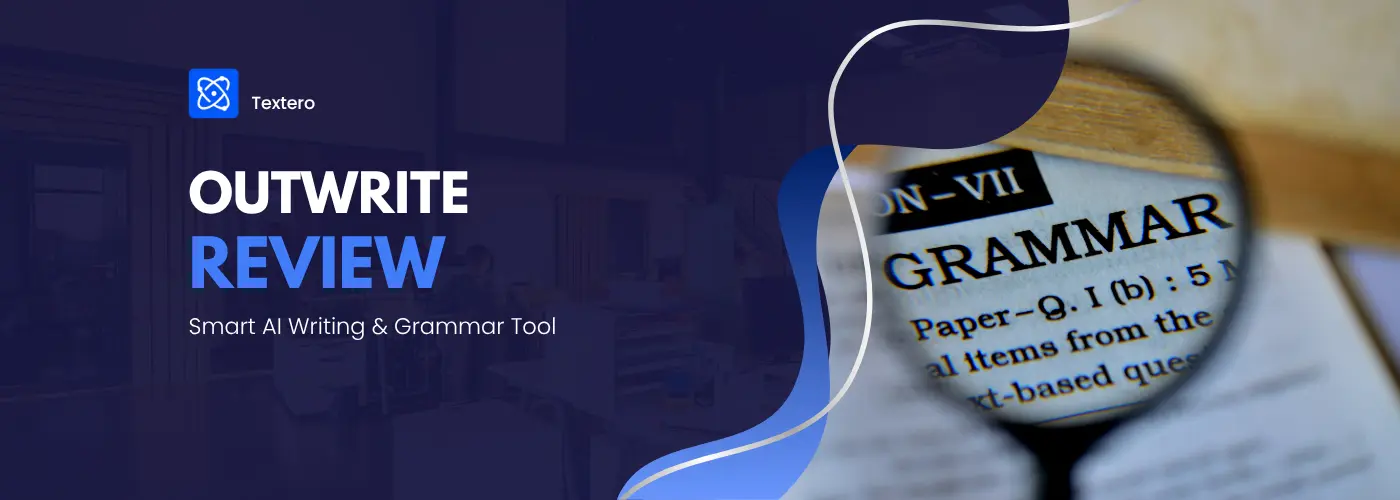Scalenut AI Review: Content Writing & SEO Platform

After months of testing various AI writing platforms for my marketing projects, I decided to share my impression of using Scalenut with all those who consider including it in their professional toolbox. I came to it with high hopes, intrigued by the promise of not just generating content, but generating SEO-optimized content. Scalenut positions itself as an all-in-one AI writing and SEO assistant, primarily targeting SEO specialists and content teams who need to create all types and forms of marketing-oriented texts. But is it as good as it seems at first sight?
I’ve tried my best to write a Scalenut review with a comprehensive and unbiased look at my experience, including all the good, the bad, and the unexpected. Therefore, you are welcome on this journey with me to discover key features, weigh its pros and cons, analyze its pricing, and discuss who it’s truly for. I will also suggest an alternative for those who might find Scalenut’s power (and price tag) more than they need. Let’s go.
What is Scalenut?
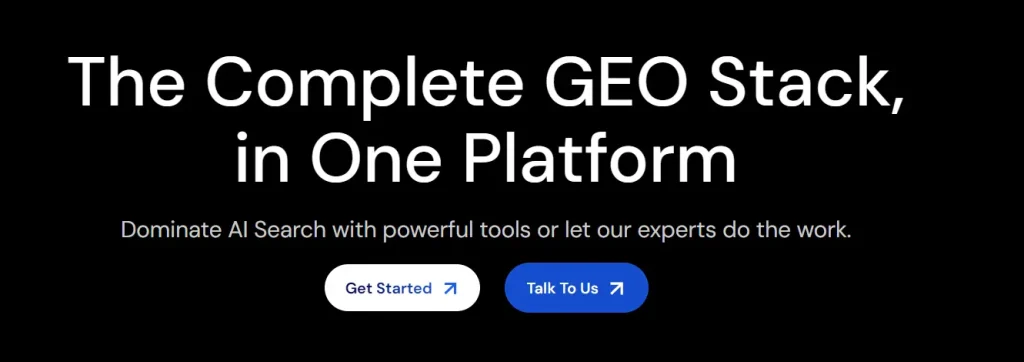
It’s no secret that there are hundreds of similar AI tools that generate text from a prompt and help marketers create messages that attract the attention of users. So, what’s that unique characteristic that makes the Scalenut writer stand out in this kaleidoscope of platforms?
I would say that the core distinction is its deep integration of SEO insights, including keyword research, competitor analysis, and content optimization recommendations. Therefore, this tool combines artificial intelligence with SEO best practices and helps you streamline the entire content creation workflow, starting from initial keyword research to performance tracking.
What sets Scalenut writing apart from other AI tools is its heavy emphasis on SEO effectiveness. While platforms like Jasper or Copy.ai focus on content quality and variety, Scalenut integrates SEO considerations into every aspect of the content creation process. That’s why you might need additional tools to detect and fix AI-generated text, because, according to my experience, the content you get often feels too generic and unappealing.
Key Features: What It Can Actually Do
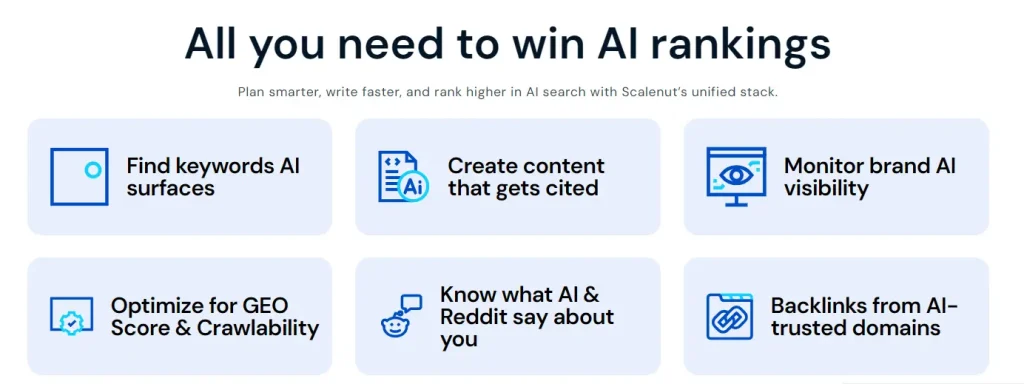
In this section, I’m going to mention Scalenut features that I found to be the most useful and impactful.
AI Copywriting
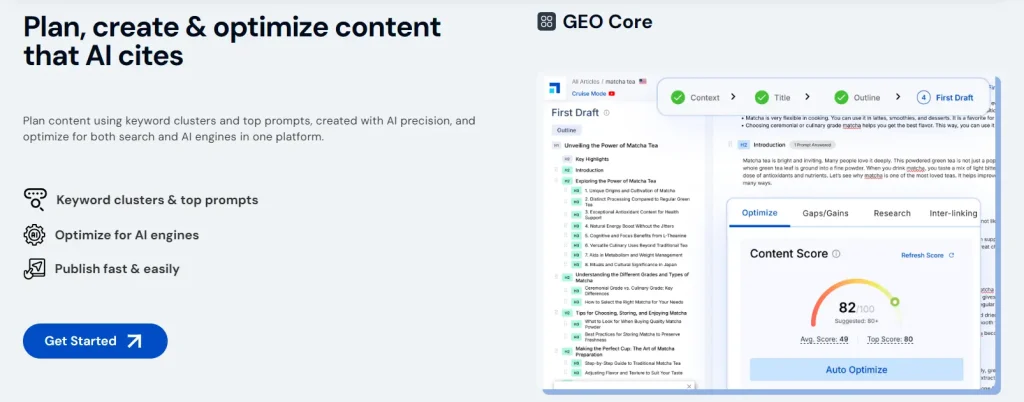
Scalenut AI technology can boast of having an impressive library of over 40 templates for various content types, such as ad copies (for Google, Facebook, etc.), email subject lines, and product descriptions. During my testing, I found the blog post generator particularly helpful, as it can create detailed articles on complex topics and maintain focus on the required keywords.
I also noticed that the generated content often feels too basic and requires significant editing to adjust the style and tone to the necessary brand voice. There’s a built-in option of humanizing content, but I didn’t find it very helpful, as it lowers the AI score insignificantly in most cases. I used other tools to reword text and make it sound more human-like. Overall, I guess it’s a quick way to overcome writer’s block for short-form content, especially when I get too annoyed staring at a blank page in front of me.
Long-Form Content Generator

This is where the tool meets your expectations and becomes your go-to platform for content creation. The writing process itself is a guided workflow: you enter a target keyword, and AI analyzes the top-ranking SERP results, generates an outline, and then writes the content based on that outline:
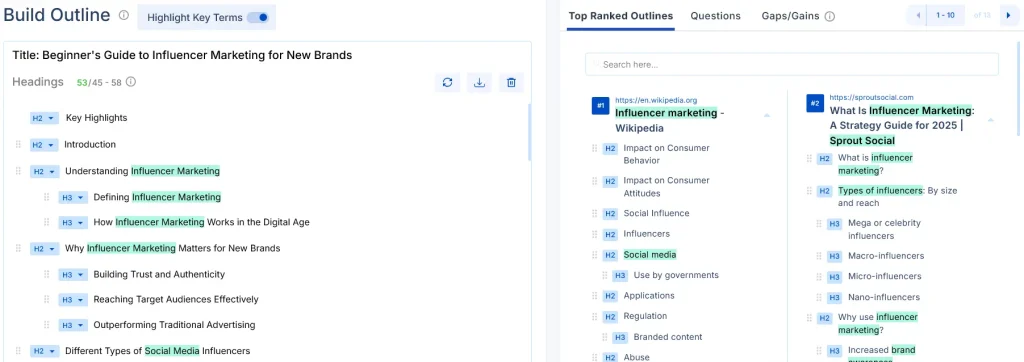
Then, the writing magic begins, and you need to wait for your article to appear on the screen patiently:
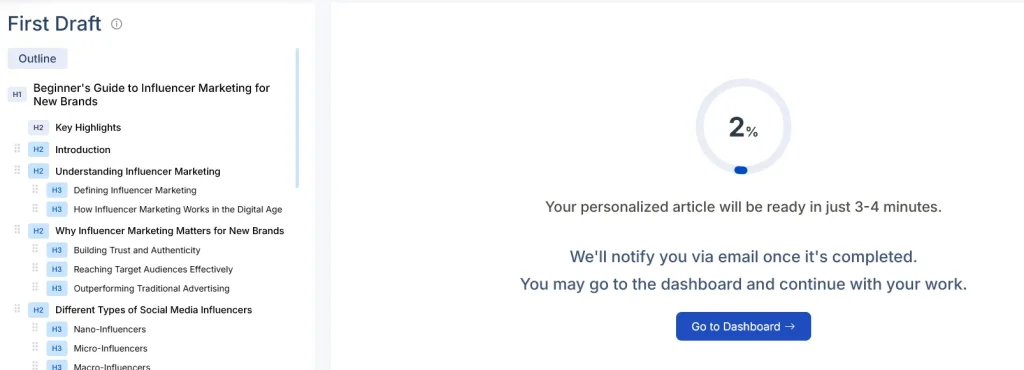
While the promise is “3-4 minutes,” the reality is that you will have to wait a bit longer to get a guided first draft. The downside of this draft is that it has obvious characteristics of an AI-generated text, while the benefit is that it gives you a well-structured document with all the right SEO elements in place.
All in all, while this approach is excellent for SEO, it sometimes results in content that feels predictable and similar to what’s already ranking, which can be a limitation for brands trying to establish thought leadership.
SEO Hub
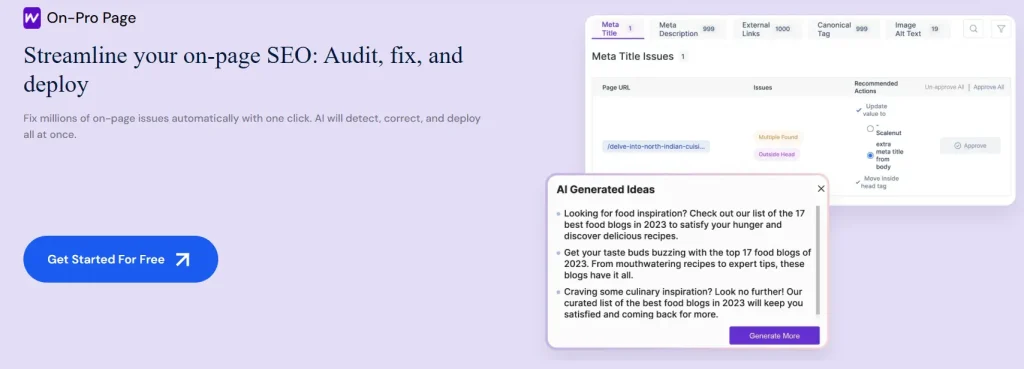
As a tool with a strong focus on SEO effectiveness, it has many beneficial functions that help you reach the desired goals:
- Keyword clustering helps you organize related keywords into content topics and create content that targets multiple search terms. Instead of writing one article for a single keyword, you can plan a series of interconnected articles that cover a broader topic.
- SERP analysis for your target keyword provides a breakdown of the top-ranking pages, including their word count and the key terms they use. For more precise results, you can also use an AI research assistant, as I found this tool to be quite helpful. Therefore, you get a clear understanding of what your content needs to include to be competitive.
- Content editor is another great feature. If you’ve ever used Surfer SEO (and who hasn’t, right?), you’ll find an obvious resemblance to Scalenut’s text editor, as it shows all the key aspects of your article. It suggests NLP terms to include and a target word count.
Integrations
It’s great that the Scalenut offers integrations with popular content management systems, such as WordPress, because you can publish content directly from the platform. The WordPress integration worked smoothly in my testing, though I found myself still preferring to copy and paste content rather than publish directly. On top of that, the Chrome extension is a handy tool for generating content on the fly, directly within your browser.
How Much Do You Need to Pay for Using It
Now, it’s time to discuss the Scalenut pricing system, as you need to analyze whether the above-mentioned features are worth the cost you have to pay. As usual, you can choose between monthly and annual plans of three types:

- Essential Plan is the most basic option, which might be best for freelancers. It offers a limited number of SEO articles and a cap on AI words.
- Growth Plan provides more words and articles, and is a preferable choice for growing businesses and small teams.
- Pro Plan targets large agencies and marketing teams, as it includes all possible features with higher limits, advanced analytics, and priority support.
On top of that, you can buy the following optional add-ons:
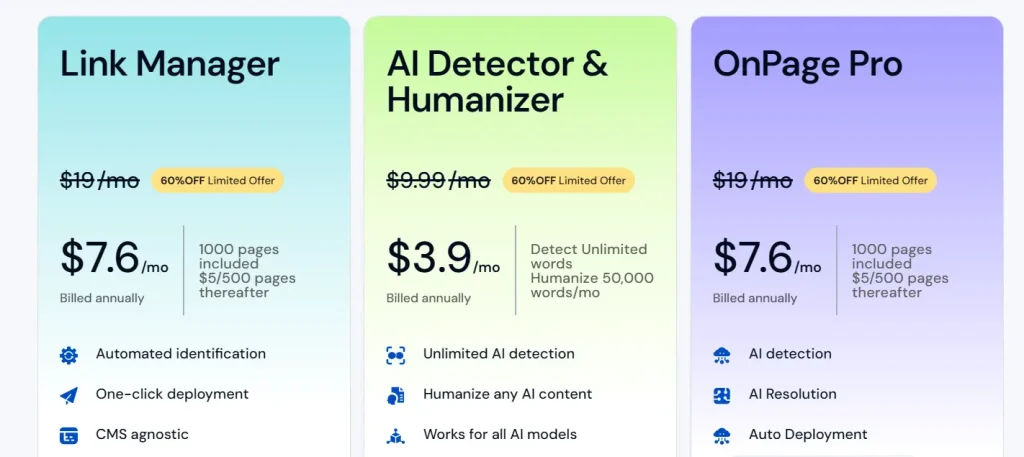
Looking at these numbers alone, it’s hard to say whether this pricing approach is reasonable. Therefore, I compared it to the tool’s competitors. For instance, Jasper, which is more of a pure AI writer, is often cheaper for a comparable number of words. Scalenut is also more expensive than Copy.ai or Writesonic, which have a broader focus and are more affordable for general-purpose content generation.
Scalenut AI Pros and Cons
No matter how close a tool might get to perfection, there will always be room for improvement. Let’s look at some of its strengths and weaknesses according to Scalenut AI reviews and my personal experience.
Pros
Strong SEO Focus
The one thing I can be sure of is that the SEO Hub, Content Editor, and keyword clustering tools provide a level of strategic insight that most AI writers lack. It helps you create texts with a logical structure that have a high chance of ranking on Google.
Strong keyword research
The ability to discover long-tail keywords and understand keyword difficulty makes Scalenut one of the best tools for content planning and SEO strategy. If you need a data-backed plan for your content, this is the right place to get it.
Variety of Content Templates
As a marketer who needs help with all types of content in addition to blog articles, the numerous templates for short-form content make a big difference.
Content Analysis
The available content analysis features help you understand what makes your articles and social media posts successful in search engines. It’s also helpful for identifying gaps in your content strategy, especially when you work in a competitive industry.
Cons
Expensive pricing structure
I’ll be honest and say that the price of any writing tool is often the deciding factor for me. I mean, I haven’t used a tool that would easily convince me to pay an incredibly high price just because it’s that good. That’s why I believe that Scalenut’s subscription plans can be a major obstacle for freelancers, small businesses, and students, who will most probably go for more affordable tools.
Not Easy to Get Your Head Around
It’s important to look at the variety of the tool’s features from both sides, positive and negative, the latter being its steep learning curve. To get the most out of the platform, you need a solid understanding of SEO principles or to spend a considerable amount of time learning how to use all of its functions effectively.
Not Ideal for Casual Users
If your goal is simply to write a personal essay, a creative story, or a school paper, Scalenut is overkill. Its focus is so heavily on SEO that its capabilities for general-purpose writing are less flexible and less intuitive than some of its competitors.
Limited Creativity
The emphasis on SEO and following specific content structures may limit your ability to create innovative content that contributes to the existing discussion. In addition, the generated text won’t bypass AI detection and needs fact-checking for inaccuracies.
Who Should Use Scalenut to Benefit From It the Most
As you’ve already understood from my previous statements, Scalenut is not for everyone, even though it has many impressive functions. So, who should use it according to my personal considerations?
- SEO professionals and agencies. If your job is to create content that ranks, and you understand concepts like SERP analysis and topic clusters, Scalenut AI is a game-changer, as it automates the most time-consuming parts of the SEO content workflow.
- Content marketers. For marketers who need to produce a high volume of SEO-driven blog posts and web pages, Scalenut provides the tools to do so efficiently and at scale.
- Bloggers. If your blog is a business and you rely on organic search traffic to grow, this tool can be a valuable investment to help you get ahead of your competitors.
My Experience with Scalenut
Even though my single review is definitely not enough for you to get an objective overview of the tool, it will help you create a general understanding of what to expect. Therefore, I decided to put Scalenut writing capabilities to the test and write a blog post with its help. The topic I chose is in no way original and quite popular – “The Rise of AI in Content Marketing.”
Step #1: Keyword Research
I started in the SEO Hub, entering my target keyword. Scalenut provided a detailed SERP analysis, showing me the average word count of top-ranking articles and the key terms they used, including relevant long-tail keywords. I have nothing bad to say about this stage of the process, as everything ran smoothly.
Step #2: Cruise Mode
Then, I used Cruise Mode to generate the first draft and got a structured outline with a few hundred words of content for each section. The output was OK. What I really liked is that the AI included relevant statistics that were mostly correct (I still needed to double-check them just in case they had nothing to do with reality).
As to the quality of the article I got, I must say that it read like a compilation of existing knowledge rather than an original perspective on the topic. That’s why I spent a lot of time injecting personality and ensuring the tone matched my intended brand voice.
Step #3: Editing and Optimization
As you’ve understood, I spent the majority of my time in the Content Editor. The real-time SEO score was helpful in guiding my edits and ensuring I included all the suggested key terms and hit the target word count. The additional tool I used was a paragraph expander to speed up the process and get tips on what to add to the article. I also liked the platform’s content grading system, which provided clear feedback on areas for improvement. This is where the “human in the loop” is essential because, to me, AI is a powerful assistant, not a replacement.
The key takeaway for me is that it took more than “3-4 minutes” to create valuable and readable content for real users. Nonetheless, the total time, including editing and polishing, was still a fraction of what it would have been without the tool.
Other Tools You Can Consider Using Instead of Scalenut
If, after reading this article, you aren’t impressed with this tool and want to look for a Scalenut AI alternative, I’ve got several options that I use regularly and can recommend.
- Jasper focuses more on content quality and brand voice than SEO optimization. It does have some SEO features, but it’s more effective to use it for creating personality-driven content that feels more natural than Scalenut’s texts.
- Copy.ai is excellent for short-form content like social media captions and ad copy. It’s generally more affordable than Scalenut and has a more user-friendly interface for general tasks, but it is less focused on deep SEO.
- Writesonic is somewhere in between Scalenut and simpler alternatives. It’s more affordable and user-friendly while still providing valuable tools, though not as extensive as Scalenut’s SEO functions.
- Textero represents a completely different approach to AI writing assistance that many students and academic writers will appreciate. Rather than focusing on SEO and marketing content, Textero specializes in academic writing and research assistance. At just $8/month, it’s significantly more affordable for students than Scalenut.
Final Verdict: Is Scalenut Worth It?
My experience with Scalenut was a positive one in general, but it confirmed that it is a specialized tool for a specialized job. It’s not a Swiss Army knife for all writing needs but rather a purpose-built platform for creating content that ranks.
FAQ
Is Scalenut free?
No, Scalenut doesn’t offer a free plan. They provide a 7-day free trial, but their paid plans start at $49/month for the Individual plan. You can use the free trial period to test out some of its basic features and see if it’s a good fit for your needs before subscribing.
What makes Scalenut different from Jasper?
The key difference is that Jasper prioritizes content quality and brand voice over SEO features. Scalenut integrates powerful SEO features like keyword clustering directly into its workflow, helping you optimize content to rank on search engines, while Jasper excels at engaging writing.
Does Scalenut really help with SEO?
Yes, Scalenut’s SEO features, such as keyword research, SERP analysis, content optimization suggestions, and competitor insights, are really helpful. However, the generated content requires editing to feel natural, and the SEO benefits depend on your understanding of optimization principles.
Is Scalenut good for beginners?
Not particularly, because even though it has a user-friendly interface, the platform requires some understanding of SEO principles. Therefore, it’s best for users who are already familiar with those.
What’s the best alternative to Scalenut?
The best alternative depends on your needs. For a more general-purpose AI writer, Jasper or Copy.ai are strong contenders. For students and casual users who need a more flexible writing tool, Textero is a great alternative as it’s more affordable and focused on academic work.

